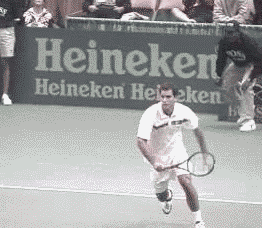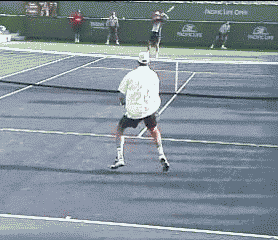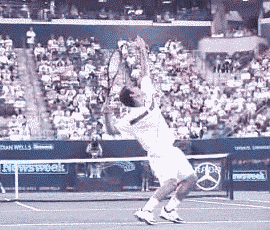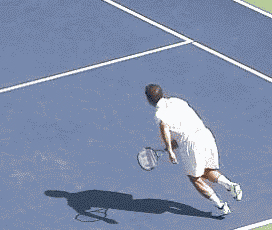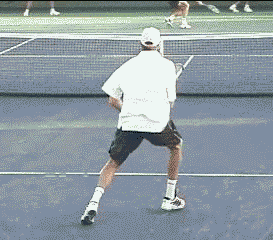|
TennisOne Lessons Nonlinear Tennis Corner:
|
|
|
No matter, how the ball is hit at them these guys remain flinchless at net. They rip sharp angles and deep baseline volleys with the same ease as they find the most delicate touch on their "drop volleys" or "lob volleys." These standout knights of the net are none other than Pete Sampras, Stefan Edberg, and Roger Federer. Not to confuse them with the great volleyers, John McEnroe, Justine Henin-Hardene, Patrick Rafter, and Tim Henman, the "knights" are extraordinary in that they are the most natural looking, effortless, efficient, and precise swordsmen at net.and did I mention their volley technique is just so pretty.
So why do these three players stand-alone? What is the qualitative difference between the conventional and the exceptional volley? How can this extraordinary "magic" be best described and understood? And can you take advantage of this knowledge and incorporate it into your game?
|
|
The "classic" volley has always been perceived and taught as a "short block" or "punch" at the ball, "out in front" or "early," with the "racquet head up," stepping across your body and "into it". These barked commands are all we've ever heard from pros, ex-touring players, and TV commentators for years. (It's no wonder the game, for the most part, has stayed in the backcourt.)
Although this conventional approach (method?) is certainly easy enough to say (teach?) and comprehend (learn?), it falls painfully short of describing how Sampras' volleys are actually hit. The "punch volley", as it is known, can only be mediocre at best -- a lower quality hit, and aesthetically less pleasing than a natural, nonlinear volley. Whereby the punch volley is just that, a punch, the racquet face "collides" with the ball. The higher quality volley, the one that epitomizes projective geometric principles, contacts the ball in such a way as to give the player a feeling of "grabbing" the ball and flinging it with razor-like precision on a dime.
|
|
Also, because you're directing your strings to the area you're aiming at you cannot disguise the volley from your opponent. This is precisely why Serena Williams lost in the French finals to Justine Henin-Hardene.
At 5-4, ad, in the third and with Henin off the court, she was facing an easy forehand volley into an open court. Well, Serena laid her racquet face open, stepped into it, and blocked the volley cross-court, whereby, Justine practically saunters over and hits the down the line forehand passing shot for an outright winner. Pete would clip that away in his sleep. And by the way, the commentator of the match stated how Serena should have punched the volley away. Fact is, Serena did punch it, and that is precisely what cost her the title.
Let me re-introduce some terms and concepts that might explain Sampras' exceptional volley, and how it's produced. And believe me, his (as Edberg's and Federer's) is the furthest thing from a punch volley.
|
|
Notice too how Pete¹s left hand draws inward, palm still slightly curved towards the center, keeping his entire body at the 45º. Pete¹s hitting arm goes from slightly concave to slightly convex as his arm and racquet stretch into the 45, and the ball is contacted as that transition is made.
Notice too how Pete's left hand draws inward, palm still slightly curved towards the center, keeping his entire body at the 45º. Pete's hitting arm goes from slightly concave to slightly convex, and the ball is contacted as the transition is made. That transition is the 45º line, that is the point of infinity, the bisection of the vertical and horizontal planes.
Watch how after Pete contacts the ball his racquet just trails off into the 45º and virtually disappears into an almost "no finish." Do you see him pushing or punching or bringing his racquet face forward towards the net? Don't think so. This magic can only be explained in nonlinear terms. Much like Bruce Lee's deadly four-inch punch, the volley ripples out from the center (of the body), as the hitting arm and racquet unfold along the 45º line. The force, moving from the body's center (hips) out to the ball at the furthest point from the center (creating leverage, like a whip) produces the most deadly efficient and heaviest of hits.
|
|
Additionally, at the point of contact (the 45º angle), the player can disguise the shot, hitting cross-court or down the line with the slightest adjustment of the racquet face massaging the ball.
As I've mentioned before, the 45º angle is geometrically the ideal point for the ball and racquet face to merge. It is precisely at that convergence point that the point (ball) and plane (racquet face) become one.
See here how Pete switches direction of the volley yet his focus and delivery is still out to the 45º. It's impossible to know where his shot is going because the angle of his racquet face changes so slightly. That is precisely why when Pete came to net he owned you.
Let's compare and see the difference between the good and the great.
Greg Rusedski, is a heck of a player, but he's not going down in my history book as one of the great volleyers. On the backhand volley, notice how he begins by laying the racquet head back. (I call this the tail wagging the dog.) Only afterward does he turn his hips, locking them in place sideways during the hit, pushing his racquet face forward and never getting to the sweet spot of the ball at the 45º angle.
He is literally squared off to the ball and net and drives the hit with his arm. You can see at the point of contact his racquet face never merges with the 45º plane. His ball somewhat floats to a general area, and you can see he's now waiting to get passed or lobbed.
|
|
Now watch his forehand volley. Once again he opens the racquet face, losing control of his left hand. The he reaches forward and out in front to contact the ball. Clearly, he is not contacting the ball facing it at the 45º. Because of that he's off-balance, relative to Sampras. His rear is sticking up in the air and he looks stiff. Therefore his aim is not nearly as precise as compared with that of the greats Sampras, Edberg or Federer.
Even Rafter, a guy whose well known for being a net player doesn't quite have the magic and ease of Sampras. Because he's not at the 45º at contact, his whole stroke seems to breaks down. He doesn't lay into the ball the way the best volleyers do. Granted he was hard to pass, but he never had the precision placement and power with the ease and grace of our three heroes. There is a big difference, if you know what to look for.
Try these two drills to improve your volley and practice the principles of the nonlinear game.
- Universal Volley - Get on your 8Board®, placed parallel to the net about 3 ft. behind. Swivel your feet slowly from forehand to backhand (45º to 45º), from side to side, your feet remaining parallel, keep your racquet head up (at 45º), creating and infinity sign (sideways Figure 8). Have someone (or a ball machine) feed you forehands and backhands. Notice how the 45º angle helps you stay upright, comfortable and balanced, with power and control, expending minimal effort.
-
Two Man Clacker - You and a partner, on opposite sides of the net, stand halfway inside the service line, each of you facing the 45º angle on the forehand side. Volley back and forth, forehand to forehand, staying focused on keeping your racquet tip pointing to the 45, hitting the ball with just a small hip movement, pulling the hip in and out of the contact. You barely need to touch the ball if you stay on the 45º. You get closer and closer until "Clack!" The ball is pressed between the two racquets. It's quite simple once you understand the 45º and moving in and out, synchronizing your hips and the ball.
Two Man Clacker Drill
Next article, I may look at few more players and show why they're still journeyman and what keeps them from being a part of today's tennis elite.
Your comments are welcome. Let us know what you think about Jack Broudy's article by emailing us here at TennisONE
8Board Tennis System
If any of my articles regarding the nonlinear game and the 8Board® Tennis System strike a chord in you, whereby you can see the wisdom and intelligence in the game, please join us at our Grail Tennis Winter Forum in Southern California, January 11th and January 18th.
If you¹re interested in the Forum, the 8Board®, or our geometric approach to tennis, golf, and other sports visit our site at www.8Board.com, see Instructional Videos, order 8Boards, DVDs and other products to Play
the 8Way. Or call 1-888-472-4577
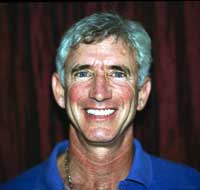 Jack Broudy was born and raised in Stamford, Connecticut and although he was active in many other sports activities, decided at age 14 he would pursue tennis as a career. He played in National Junior tours, the NCAAs, won many titles as a kid and went on to play winning tennis though his college years both at the University of North Carolina at Chapel Hill and UC San Diego.>
Jack Broudy was born and raised in Stamford, Connecticut and although he was active in many other sports activities, decided at age 14 he would pursue tennis as a career. He played in National Junior tours, the NCAAs, won many titles as a kid and went on to play winning tennis though his college years both at the University of North Carolina at Chapel Hill and UC San Diego.>
Broudy began working and collaborating with Paul Mayberry 10 years ago. Together they developed the 8Board Body Motion Coordinating System of training that has allowed Broudy's students to play World-class tennis and become national tournament winners. Currently Broudy coaches nationally ranked juniors and touring pros at the Four Seasons Aviara Resort in Carlsbad, CA. The author of The Real Spin on Tennis, Broudy is also a contributing writer for Tennisone.com, a tennis player, surfer, and musician.
He serves as president of Grail Sports, Inc.

